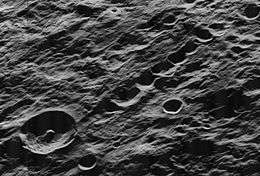Leuschner (crater)
Leuschner is a lunar impact crater that is located on the Moon's far side, to the northwest of the Montes Cordillera. It lies to the north of the crater Grachev, in the outer skirt of ejecta surrounding the Mare Orientale impact basin. This is a circular crater with a rim that has only been lightly eroded by subsequent impacts. Within the interior floor is a central ridge formation.
 LRO WAC image | |
| Coordinates | 1.8°N 108.0°W |
|---|---|
| Diameter | 49 km |
| Depth | Unknown |
| Colongitude | 108° at sunrise |
| Eponym | Armin O. Leuschner |

The Catena Leuschner is a crater chain formation that begins at the northern outer rim of Leuschner and runs to the northwest towards the crater Kolhörster. This feature is radial to the Mare Orientale impact, and was likely caused by larger chunks of ejecta during the formation of that feature.
Satellite craters
By convention these features are identified on lunar maps by placing the letter on the side of the crater midpoint that is closest to Leuschner.
| Leuschner | Latitude | Longitude | Diameter |
|---|---|---|---|
| L | 1.1° S | 108.8° W | 18 km |
| Z | 5.3° N | 109.3° W | 18 km |
See also
- 1361 Leuschneria, minor planet
References
- Andersson, L. E.; Whitaker, E. A. (1982). NASA Catalogue of Lunar Nomenclature. NASA RP-1097.CS1 maint: ref=harv (link)
- Blue, Jennifer (July 25, 2007). "Gazetteer of Planetary Nomenclature". USGS. Retrieved 2007-08-05.CS1 maint: ref=harv (link)
- Bussey, B.; Spudis, P. (2004). The Clementine Atlas of the Moon. New York: Cambridge University Press. ISBN 978-0-521-81528-4.CS1 maint: ref=harv (link)
- Cocks, Elijah E.; Cocks, Josiah C. (1995). Who's Who on the Moon: A Biographical Dictionary of Lunar Nomenclature. Tudor Publishers. ISBN 978-0-936389-27-1.CS1 maint: ref=harv (link)
- McDowell, Jonathan (July 15, 2007). "Lunar Nomenclature". Jonathan's Space Report. Retrieved 2007-10-24.CS1 maint: ref=harv (link)
- Menzel, D. H.; Minnaert, M.; Levin, B.; Dollfus, A.; Bell, B. (1971). "Report on Lunar Nomenclature by the Working Group of Commission 17 of the IAU". Space Science Reviews. 12 (2): 136–186. Bibcode:1971SSRv...12..136M. doi:10.1007/BF00171763.CS1 maint: ref=harv (link)
- Moore, Patrick (2001). On the Moon. Sterling Publishing Co. ISBN 978-0-304-35469-6.CS1 maint: ref=harv (link)
- Price, Fred W. (1988). The Moon Observer's Handbook. Cambridge University Press. ISBN 978-0-521-33500-3.CS1 maint: ref=harv (link)
- Rükl, Antonín (1990). Atlas of the Moon. Kalmbach Books. ISBN 978-0-913135-17-4.CS1 maint: ref=harv (link)
- Webb, Rev. T. W. (1962). Celestial Objects for Common Telescopes (6th revised ed.). Dover. ISBN 978-0-486-20917-3.CS1 maint: ref=harv (link)
- Whitaker, Ewen A. (1999). Mapping and Naming the Moon. Cambridge University Press. ISBN 978-0-521-62248-6.CS1 maint: ref=harv (link)
- Wlasuk, Peter T. (2000). Observing the Moon. Springer. ISBN 978-1-85233-193-1.CS1 maint: ref=harv (link)